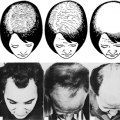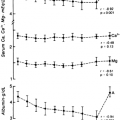NATURAL HISTORY OF THE SKELETON
Part of “CHAPTER 50 – PHYSIOLOGY OF BONE“
In humans, the skeleton continues to grow until 25 to 35 years of age. Before puberty, the bones grow by periosteal apposition and
endosteal resorption. During puberty and adolescence, a period of endosteal apposition and thickening of the trabeculae occurs, so that bone mass increases by 10% to 20% even after linear growth has ceased.6 During the years from 20 to 50, bone mass is stable, because rates of formation and resorption are equal or coupled. The formation of new BSUs both in the cortex and on the surface of trabecular bone continues throughout life. Later in life, bone mass begins to decrease due to uncoupled remodeling. Age-related bone loss is greater for trabecular than for cortical bone, and more rapid in women than in men, largely because of the acceleration of remodeling at menopause. Bone mass can decrease simply because more BSUs are formed (increased turnover), because a time gap exists between resorption and formation even when the processes are coupled. This deficit is theoretically reversible if the rate of turnover decreases and the formation phase is allowed to proceed to complete replacement. Uncoupled remodeling can occur because so much endosteal or trabecular bone is removed that a template for osteoblastic replacement no longer exists. Thus, areas may appear in which trabecular plates develop holes or are converted to attenuated rods. Finally, the ability of successive populations of osteoblasts to complete the formation process is impaired with age, so that haversian canals remain enlarged and trabecular surfaces show only partial replacement of resorbed bone with small BSUs, that is, thinner packets of new bone.
endosteal resorption. During puberty and adolescence, a period of endosteal apposition and thickening of the trabeculae occurs, so that bone mass increases by 10% to 20% even after linear growth has ceased.6 During the years from 20 to 50, bone mass is stable, because rates of formation and resorption are equal or coupled. The formation of new BSUs both in the cortex and on the surface of trabecular bone continues throughout life. Later in life, bone mass begins to decrease due to uncoupled remodeling. Age-related bone loss is greater for trabecular than for cortical bone, and more rapid in women than in men, largely because of the acceleration of remodeling at menopause. Bone mass can decrease simply because more BSUs are formed (increased turnover), because a time gap exists between resorption and formation even when the processes are coupled. This deficit is theoretically reversible if the rate of turnover decreases and the formation phase is allowed to proceed to complete replacement. Uncoupled remodeling can occur because so much endosteal or trabecular bone is removed that a template for osteoblastic replacement no longer exists. Thus, areas may appear in which trabecular plates develop holes or are converted to attenuated rods. Finally, the ability of successive populations of osteoblasts to complete the formation process is impaired with age, so that haversian canals remain enlarged and trabecular surfaces show only partial replacement of resorbed bone with small BSUs, that is, thinner packets of new bone.
Stay updated, free articles. Join our Telegram channel

Full access? Get Clinical Tree





